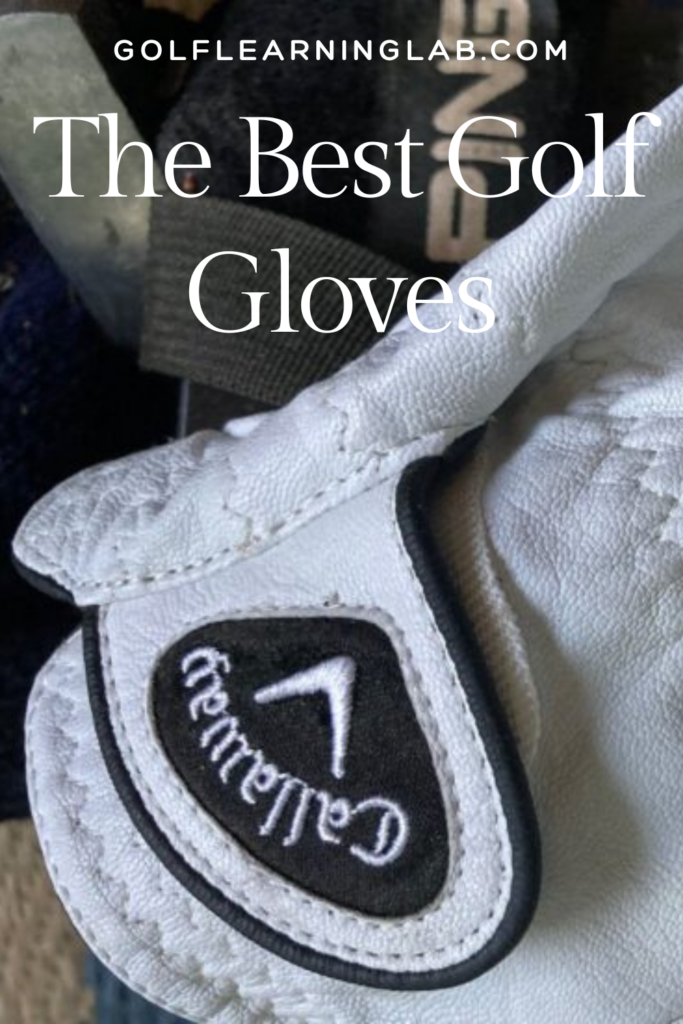Best Golf Gloves: The Perfect Fit for Your Game
Last Saturday morning started like any other. I got up- hit the coffee pot hard, clubs were ready, and the weather was acceptable (I’m kind of a puss when it comes to cold rain). I arrived at the course early to get in some practice swings on the range before my tee time. As I pulled out my driver on the range and took my stance, something felt off. Looking down at my hand, I discovered the culprit: a huge hole had formed between the thumb and index finger of my glove. I knew about it- and I had meant to get by Academy or somewhere- and I just got busy and didn’t do it! Talk about bad timing!
With my tee time approaching quickly and already at the course, I had only one option—the pro shop. When you go to the pro shop, it’s kind of like having your old car break down in front of the dealership. They KNOW they have you!
What I wasn’t prepared for was the sticker shock. $35 for a single glove? I stood there, the FootJoy glove in my hand, debating whether to make the purchase. The irony wasn’t lost on me—buying a “FootJoy” product for my hand! The little girl behind the counter (I’m positive that she’s an expert) assured me it was “a good one”, but I couldn’t help wondering if it was really that much better than the $12 option I could get elsewhere. Nevertheless, with no time to spare and a huge blister on my hand at stake, I reluctantly handed over my credit card.
This experience got me thinking about golf gloves in general. Are expensive options truly worth it? What makes a good golf glove? And most importantly, which are the best golf gloves for different budgets and playing styles? After some research and personal testing, I’ve put together this guide to help players make informed decisions without breaking the bank.
Why Golf Gloves Matter
Before diving into specific recommendations, let’s address why golf gloves are important equipment rather than just an accessory. A quality golf glove serves multiple crucial functions that directly impact your game:
First and foremost, grip security. During a swing, your club can reach speeds of over 100 mph. Without proper grip, the club could literally fly out of your hands or twist upon impact, (we at GLL have personally experienced this) sending your ball AND CLUB who-knows-where. A good golf glove provides the friction needed between your hand and the club to maintain control throughout your swing.
Secondly, gloves protect your hands from developing painful blisters and calluses. If you’re playing multiple rounds per week or hitting the driving range regularly, this protection becomes increasingly important. I’ve tried playing without a glove during casual rounds, and the next day my hand reminded me why that was a mistake. Side note here… my Dad, who really taught me to play, never wore a glove. His hands were like leather though. I’m sure my Mom appreciated that- but never had that wildly awkward discussion with her!
Lastly, they can improve your confidence. When you’re not worried about your grip or hand pain, you can focus entirely on your technique and strategy. The best golf gloves provide that peace of mind, allowing you to concentrate on what really matters—your game.
Premium Golf Gloves Worth the Investment
When it comes to the upper echelon of golf gloves, you’re paying for exceptional materials, superior craftsmanship, and often- strike that- MOSTLY, professional endorsements. Here are some premium options that justify their higher price tags:
Titleist Players Flex: Made from premium Cabretta leather, these gloves offer exceptional feel and durability. The thin construction provides outstanding feedback during your swing without sacrificing longevity. At around $25-30, they’re certainly not cheap, but the quality is immediately apparent. I’ve found they maintain their shape and softness even after numerous rounds.
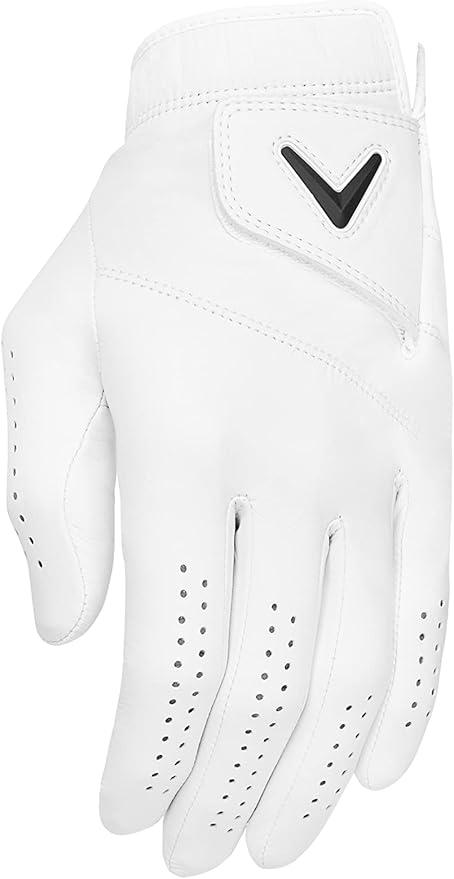
Callaway Tour Authentic: These gloves feature premium leather with perforation patterns strategically placed for maximum breathability. The attention to detail in the stitching makes them extremely durable while maintaining excellent tactile sensitivity. They’re particularly good for golfers who play in warmer climates where breathability becomes crucial. Expect to pay around $25-28 for these premium options.
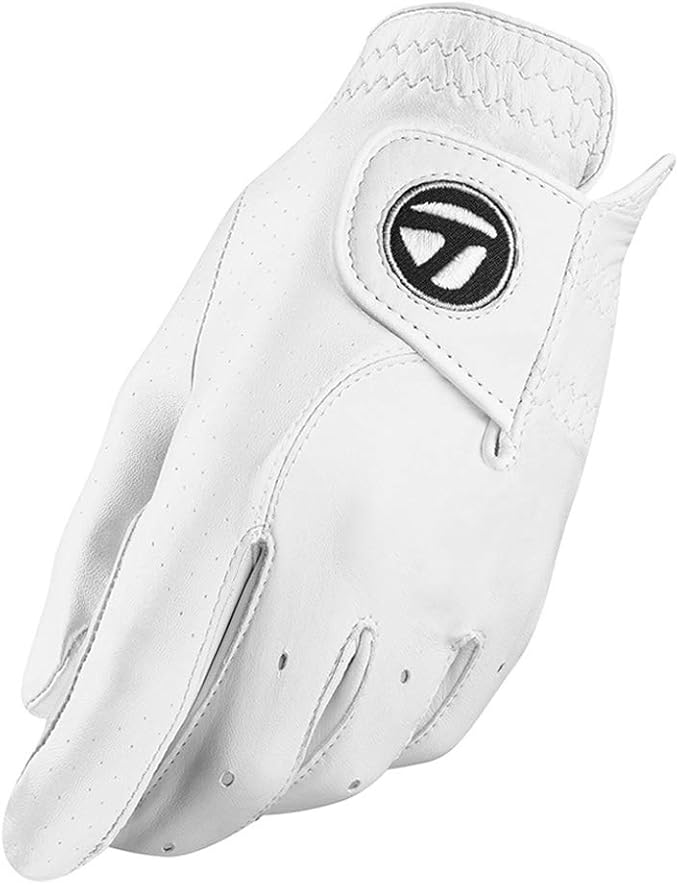
TaylorMade Tour Preferred: Used by many tour professionals, these gloves offer AAA Cabretta Soft Tech leather with antimicrobial properties. The ergonomic design and strategically placed moisture-wicking properties make them incredibly comfortable for extended play. The Tour Preferred retails for approximately $25-30 and represents the high-end of what most recreational players should consider.
While these premium gloves come with premium price tags, many serious golfers find them worthwhile investments. The difference in feel, performance, and durability compared to budget options is noticeable, especially for players with refined preferences. To be fair, these probably do last a bit longer. But, the main thing I want you to note here is that they are a hella lot cheaper at Amazon!
Mid-Range Options That Deliver
Not everyone needs or wants to spend top dollar on golf gloves. Fortunately, there are excellent mid-range options that deliver comparable performance at more accessible price points:
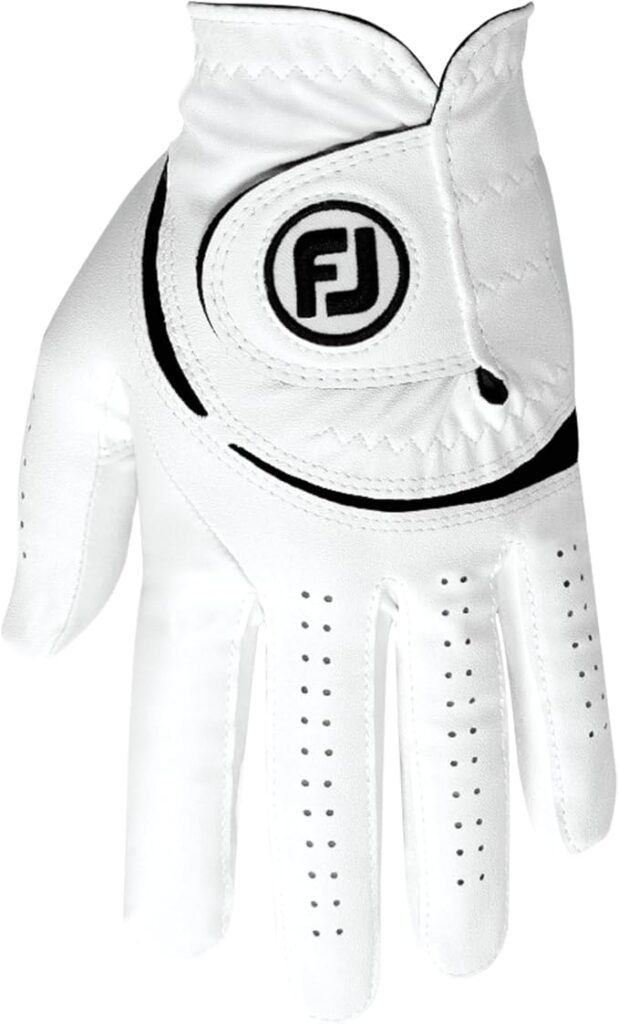
FootJoy WeatherSof: Despite my pro shop story, FootJoy does make excellent gloves. The WeatherSof combines synthetic microfiber with leather for a balance of durability and feel. At around $12-15, these gloves offer exceptional value. I’ve used these extensively and found them to last nearly as long as premium options while providing very similar performance.

Srixon Z-SRX: These gloves feature premium Cabretta leather on the palm with synthetic materials on the back for flexibility. The hybrid approach keeps the price reasonable while maintaining excellent grip characteristics. The leather palm provides the crucial feel needed for delicate shots while the synthetic back improves durability.
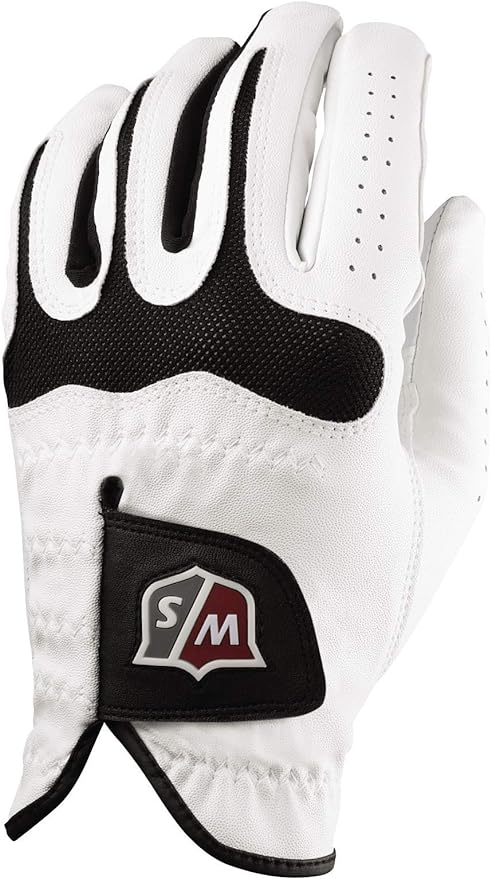
Wilson Staff Conform: Wilson might not have the prestige of some other brands, but their Grip gloves deserve attention. Made with premium materials and featuring a precision fit system, these gloves offer excellent feel and comfort at a good price point. I was pleasantly surprised by the quality and durability.
These mid-range options represent the sweet spot for most recreational golfers. They provide excellent performance characteristics without the premium price tag. Unless you’re playing multiple times per week or competing at higher levels, these gloves will likely serve you perfectly well.
Budget-Friendly Golf Gloves
Contrary to what that pro shop salesperson might suggest, you don’t need to spend a fortune to get a functional, comfortable golf glove. Here are some budget options that perform admirably:
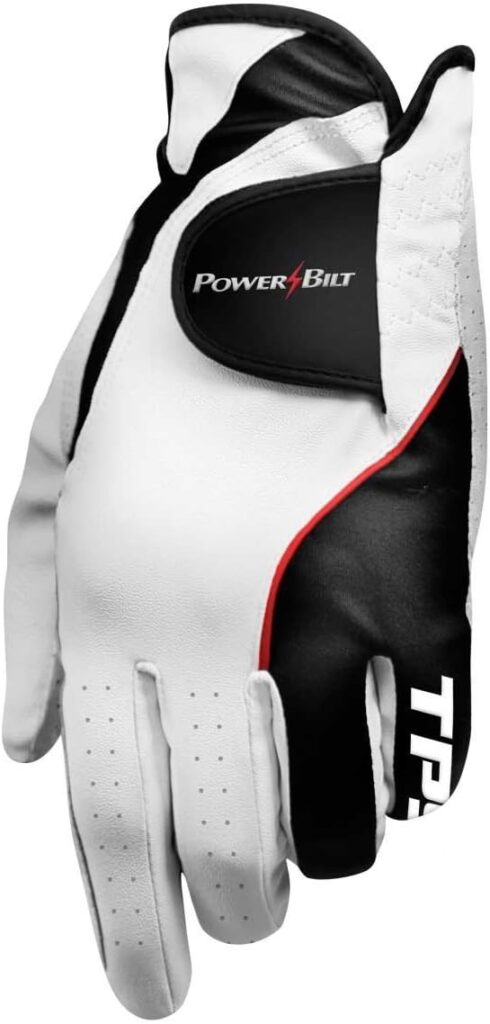
Powerbilt TPS Cabretta Tour: This brand is near and dear to my heart (my old woods)… just watch some of our Tik-Tok’s. Powerbilt offers Cabretta leather at surprising quality and bargain prices. The durability might not match premium brands, but the feel and performance are impressively close. These represent exceptional value, especially if you tend to lose gloves frequently.

Kirkland Signature Golf Gloves: Costco’s entry into golf accessories has been remarkably successful. Don’t let the price here fool you- you get like 9 of them in a pack!! Kidding- but it does make them approximately $5-7 per glove. The quality is surprisingly good, with many golfers reporting performance comparable to gloves twice the price.

MG Golf DynaGrip: These direct-to-consumer gloves cost around $8-10 and feature genuine Cabretta leather. The company claims they’re made in the same factories as many major brands but without the marketing overhead. Based on my testing, they perform admirably, though the fit can be slightly less precise than more expensive options.
When considering budget options, remember that they might require replacement more frequently than premium gloves. However, even if you need to replace them twice as often, you’re still saving money overall. For casual players or those new to golf, these budget-friendly gloves are more than sufficient.
How to Choose the Right Golf Glove
Finding the best golf gloves for your specific needs involves considering several key factors beyond just price:
Material Considerations
The primary material choice comes down to leather versus synthetic, with each offering distinct advantages:
Leather gloves (typically Cabretta leather) provide superior feel and naturally conform to your hand over time. The soft, supple nature of leather offers excellent tactile feedback during your swing. However, leather is more susceptible to moisture damage and typically costs more.
Synthetic gloves offer greater durability and often better performance in wet conditions. They’re typically less expensive and may include moisture-wicking properties. The downside is they generally don’t provide the same level of feel and sensitivity as leather.
Hybrid gloves combine elements of both, often using leather in high-contact areas and synthetic materials elsewhere. These can offer a good compromise between feel, durability, and price.
For most players, I recommend leather or hybrid gloves for dry conditions and keeping a dedicated synthetic option for wet weather play.
Fit and Sizing
The importance of proper fit cannot be overstated when selecting golf gloves. A glove that’s too tight will restrict movement and potentially cut off circulation. Too loose, and you’ll lose the crucial tactile connection with the club.
When trying on gloves, they should feel snug but not constricting. There should be no excess material at the fingertips, but your fingers shouldn’t feel cramped either. Quality gloves are sized precisely, with options often including cadet sizes for golfers with shorter fingers relative to palm width.
Most manufacturers provide sizing charts, but these can vary between brands. Whenever possible, try gloves on before purchasing. If buying online, measure your hand according to the manufacturer’s instructions and consider ordering multiple sizes to find the perfect fit.
Remember that leather gloves will stretch slightly with use, so they should feel quite snug when new. Synthetic gloves, by contrast, will maintain their original size more consistently.
Weather Adaptability
Your local climate and typical playing conditions should influence your glove selection:
For hot, humid conditions, look for gloves with perforations and moisture-wicking properties. Brands like FootJoy offer specific “hot weather” models with enhanced ventilation.
For cold weather, thermal gloves or even playing with gloves on both hands might be appropriate. FootJoy and Under Armour offer specialized cold-weather options.
For wet conditions, water-resistant or all-weather gloves are essential. FootJoy’s RainGrip and Titleist’s Players Flex Storm are excellent options when precipitation is expected.
As a general rule, I recommend having at least two types of gloves in your bag—a primary leather or hybrid option for normal conditions and a specialized glove for extreme weather.
Caring for Your Golf Gloves
Proper care can significantly extend the life of even the best golf gloves, saving you money in the long run:
After each round, allow your glove to air dry naturally. Don’t ball it up in your bag or leave it in direct sunlight. I like to flatten mine out and place it in an outer pocket of my golf bag.
For leather gloves that have gotten wet, let them dry at room temperature away from direct heat sources. Once dry, gently work the leather with your hands to restore flexibility.
Consider rotating between multiple gloves, especially during hot weather or intensive practice sessions. This allows each glove time to dry completely between uses.
For storage between rounds, use a glove shaper or simply flatten your glove between your golf bag’s interior dividers. Some players even use old plastic cards inside the glove to help maintain its shape.
Clean your gloves periodically with a damp cloth and mild soap, being careful not to saturate leather gloves. For deeper cleaning of leather gloves, specialized leather cleaners are available.
With proper care, even moderately priced gloves can last for dozens of rounds. The key is addressing minor wear before it becomes a major issue, like my driving range discovery that started this whole journey.
My experience in the pro shop taught me an important lesson about golf equipment: sometimes we pay for convenience, sometimes for quality, and sometimes just for the name on the tag. When it comes to finding the best golf gloves, I’ve found the sweet spot typically lies in the mid-range category for most recreational players. These gloves offer the performance characteristics of premium options without the premium price tag.
That said, golf is a personal game, and the right glove for you depends on your specific needs, preferences, and budget. Whether you opt for a top-tier TaylorMade or a budget-friendly Kirkland Signature, the most important factors are proper fit, appropriate material for your playing conditions.
Remember, the best golf glove isn’t necessarily the most expensive one—it’s the one that gives you confidence in your grip, allowing you to focus on what really matters: enjoying your time on the course and improving your game. Next time you’re faced with replacing a worn-out glove, consider these recommendations rather than simply reaching for whatever the pro shop has on display. Your game—and your wallet—will thank you.
